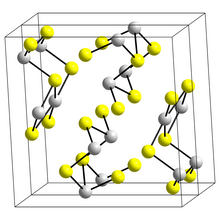 | |
 | |
| Names | |
|---|---|
| IUPAC name Bismuth(III) sulfide | |
| Other names Bismuth sulfide Dibismuth trisulfide | |
| Identifiers | |
3D model (JSmol) | |
| ChemSpider | |
| ECHA InfoCard | 100.014.287 |
| EC Number |
|
PubChem CID | |
| UNII | |
CompTox Dashboard (EPA) | |
| |
| |
| Properties | |
| Bi2S3 | |
| Molar mass | 514.14 g·mol−1 |
| Appearance | brown powder |
| Density | 6.78 g/cm3 [1] |
| Melting point | 850 ˚C [1] |
| insoluble | |
| Solubility | soluble in acids |
| −123.0·10−6 cm3/mol | |
| Hazards | |
| Occupational safety and health (OHS/OSH): | |
Main hazards | Irritant |
| GHS labelling: | |
 | |
| Warning | |
| H315, H319, H335 | |
| P261, P264, P271, P280, P302+P352, P304+P340, P305+P351+P338, P312, P321, P332+P313, P337+P313, P362, P403+P233, P405, P501 | |
| Related compounds | |
Other anions | Bismuth(III) oxide Bismuth selenide Bismuth telluride |
Other cations | Arsenic trisulfide Antimony trisulfide |
Except where otherwise noted, data are given for materials in their standard state (at 25 °C [77 °F], 100 kPa). | |
Bismuth(III) sulfide (Bi2S3) is a chemical compound of bismuth and sulfur. It occurs in nature as the mineral bismuthinite.